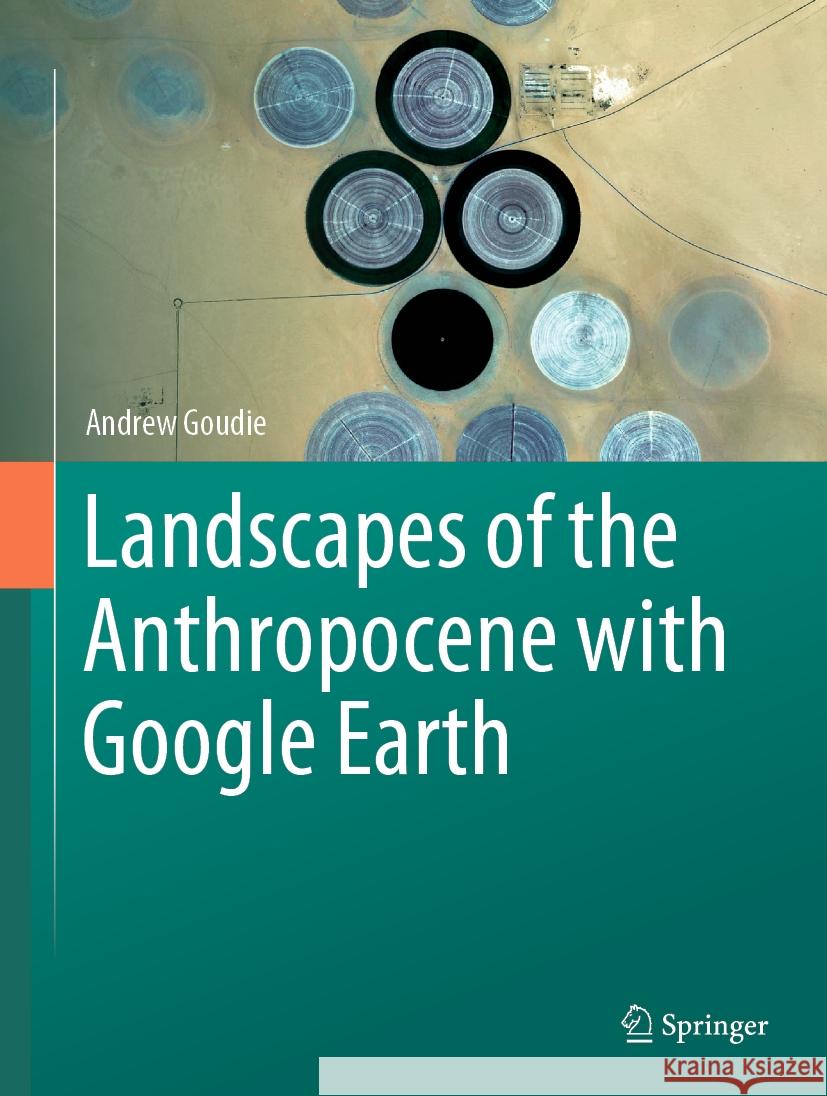Landscapes of the Anthropocene with Google Earth » książka



(netto: 651,74 VAT: 5%)
Najniższa cena z 30 dni: 655,41
ok. 22 dni roboczych.
Darmowa dostawa!
1 Introduction
1.1 Google Earth and Landscapes- Introduction
1.2 The Anthropocene1.3 The Palaeoanthropocene
1.4 The Great Acceleration
References
2 Driving Forces
2.1 Introduction
2.2 Demographic Developments2.3 Farming
2.4 Fires
2.5 Deforestation
2.6 Urbanisation
2.7 Mining
2.8 Energy Sources and the Landscape
2.9 Tourism
2.10 Climate Change
References
3 Humanly-Made landforms
3.1 Introduction
3.2 Tells and Other Mounds
3.3 Tumuli
3.4 Causewayed Enclosures
3.5 Hillforts
3.6 Defensive Walls
3.7 Moated Settlements
3.8 Qanat
3.9 Terraces and Lynchets
3.10 Mine Spoil Heaps3.11 Craters
3.12 Ponds
3.13 Conclusion: Earth Moving
References
4 Rivers
4.1 Introduction
4.2 Dams and Barriers
4.3 Inter-Basin Water Transfers
4.4 Channelization and Straightening
4.5 Levees and Dykes4.6 Flood Relief Channels or Bypasses
4.7 Canals
4.8 Changes in River Channels as a Result of Land Use Changes
4.8.1 Introduction
4.8.2 Diversity of Causes: some Examples
4.8.3 Role of Soil Conservation Measures
4.8.4 Role of Invasive Plants and of Animals4.8.5 The Role of Mining
4.8.6 Water Mills
4.8.7. Effects of Urbanisation
4.8.8 Effects of Transport Corridors
4.9 Holocene and Anthropocene Floodplain Sedimentation
4.10 Recent Changes in Sediment Loads
4.11 Fluvial Wetland Drainage
4.12 River Deltas
4.13 Flooding and Runoff Changes
4.13.1 Groundwater Depletion
4.13.2 Forest Removal
4.13.3 Afforestation
4.13.4 Riparian Vegetation and the Spread of Invasive Plants4.13.5 Swamp Encroachment
4.13.6 Land Drainage
4.13.7 Urbanisation
4.13.8 Permafrost Melting
4.13.9 Recent Climate Changes
4.14 Conclusion
References
5 The Cryosphere (Glacial and periglacial landscapes)
5.1 Introduction
5.2 Snowpack Disappearance
5.3 Permafrost Disruption and Thermokarst
5.4 Valley Glaciers and Small Ice Caps5.5 Glacial Lakes
5.6 Polar Ice Sheets and Ice Caps
5.7 Conclusion
References6 Coasts
6.1 Introduction: Coastal Modification
6.2 Deliberately Created Landforms
6.2.1 Coastal Defence Structures, Groynes, Tsunami Walls, etc.6.2.2 Artificial Islands
6.2.3 Artificial Reefs
6.2.4 Salt Pans
6.2.5 Coastal Reclamation6.3 Non-Deliberate Changes
6.3.1 Accelerated Coastal Erosion
6.3.2 Changing Salt Marshes
6.3.3 Mangroves
6.3.4 Coral Reefs
6.3.5 Estuaries
6.4 The Future
6.4.1 The Amount of Sea-Level Rise by 21006.4.2 Land Subsidence
6.4.3 Reefs
6.4.4 Salt Marshes
6.4.5 Mangroves and Forested Wetlands
6.4.6 Sabkhas
6.4.7 Cliffed Coasts
6.4.8 Sandy Beaches
6.5 Conclusion
References
7 Lakes
7.1 Introduction
7.2 Lake Contraction due to Reclamation and Sedimentation
7.3 Lake Desiccation
7.3.1 Aral Sea, Central Asia
7.3.2 The Caspian Sea
7.3.3 The Dead Sea
7.3.4 Lakes Urmia and Bakhtegan, Iran7.3.5 Lop Nor, China
7.3.6 East African Lakes
7.3.7 Salton Sea, USA7.3.8 Owens Lake
7.3.9 The Great Salt Lake
7.4 Conclusions
References
8 Ground Subsidence
8.1 Introduction
8.2 Subsidence Due to Changing Groundwater Conditions
8.3 Solutional Collapse of Salt and Gypsum
8.4 General Subsidence Due to Groundwater Exploitation
8.5 Coal Mining
8.6 Salt Mining by Solution 8.7 Hydrocarbon Abstraction 8.8 Geothermal Fluid Abstraction8.9 Induced Seismic Activity
8.10 Shrinkage of Organic Soils and Peats
8.11 Hydrocompaction of Collapsing Soils8.12 Ground Fissures (Earth Fissures)
8.13 ConclusionsReferences
9 Water Erosion and Mass Movements
9.1 Introduction: Soil Erosion by Water
9.2 Long-Term Rates of Erosion
9.3 Forest Removal and Other Land Use Changes
9.3.1 Introduction
9.3.2 Mid-Latitude Humid Regions
9.3.3 The Tropics
9.3.4 Mediterranean Land Uses
9.4 Mechanisms of Soil Loss
9.4.1 Soil Loss during Harvesting
9.4.2 Erosion by Land Levelling9.4.3 Tillage Erosion
9.4.4 Grazing
9.4.5 Grassland Replacement by Shrublands9.4.6 Irrigation Induced Erosion
9.4.7 Fire Induced Erosion
9.4.8 Urbanization, Construction and Roads9.5 Peat Erosion
9.6 Arroyos, Lavakas, Dongas, and Calanchi
9.7 Soil Conservation and Erosion Management
9.8 Slopes: Accelerated Mass Movements
9.8.1 Introduction
9.8.2 Deforestation
9.8.3 Roads
9.8.4 Mining
9.8.5 Irrigation
9.8.6 Dam Construction: the Case of Vaiont
9.8.7 Slopes, Glacier Retreat and PermafrostReferences
10 Aeolian Anthropocene
10.1 Introduction
10.2 Dust Storms and Wind Erosion10.2.1 Introduction
10.2.2 Desiccation
10.2.3 History of Dust Storms10.2.4 Dust Storms since the Mid-Twentieth Century
10.2.5 Humans or Climate?
10.3 Sand dunes
10.3.1 Introduction
10.3.2 Examples of Dune Modification
10.5 ConclusionsReferences
11 Stage 3 of the Anthropocene – Stewardship
11.1 Introduction
11.2 Conclusions
References
Index
Andrew Goudie, Ph.D., D.Sc., Emeritus Professor of Geography at the University of Oxford, a former Pro-Vice Chancellor, Honorary Fellow of Hertford College, and the former Master of St. Cross College, is Geomorphologist who led the Kimberley Research Project in 1988. He is a recipient of a Royal Medal from the Royal Geographical Society, the Mungo Park Medal of the Royal Scottish Geographical Society, and the Farouk El-Baz Award of the Geological Society of America. He is Fellow of the British Society of Geomorphologists. He has been Chair of the British Geomorphological Research Group, President of the Geographical Association, and President of the International Association of Geomorphologists. He has written extensively on the human impact and the Anthropocene.
This book considers the meaning of the term, considers the value and characteristics of Google Earth, and discusses the main driving forces of landscape change. Google Earth provides a means whereby one can identify changes in the landscapes of Earth over recent decades. This has been a time of great human activity, and landscapes have been transformed as a result of such factors as land use and land-cover change, climate change, the intensive harnessing of new energy sources, population pressures, and globalization. Many geologists now believe that the whole Earth System is being changed and that there is thus a need to introduce the concept of the Anthropocene. It then looks at specific landscape types, including rivers, coasts, lakes, deserts, tundra, and glaciers.
1997-2026 DolnySlask.com Agencja Internetowa
KrainaKsiazek.PL - Księgarnia Internetowa









